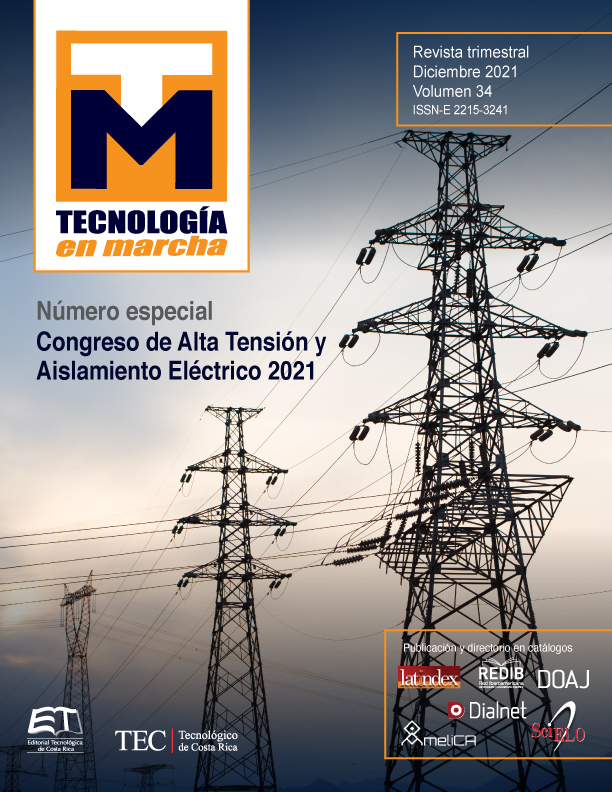Artificial neural networks for the prediction of power flows applied to the Uruguayan transmission system.
Main Article Content
Abstract
In the present work, the use of artificial neural networks is proposed to solve the load flow problem. The study of the load flow of the electrical network constitutes a fundamental tool for the operation and planning of an electrical system. The load flow problem is solved by a system of non-linear equations. For this resolution, numerical methods have traditionally been used, mainly the Newton-Raphson method and its variants. These numerical methods applied to large electrical systems are very expensive in terms of computational cost. Solving a considerable number of load flows using these methods involves incurring in execution times that are prohibitive in studies of the electrical network. This problem becomes critical in contingency case studies, even using the simple N-1 contingency criterion. The construction of neural networks that approximate the resolution of load flows allows to significantly reducing the execution time of the aforementioned studies. In this work, the design of a neural network architecture for the approximation of load flows is proposed. Using the designed architecture, a load flow approximation model is implemented. The validation of the tool is carried out using the Uruguayan transmission network. The approximation obtained for this case study is evaluated by applying the MAPE metric and a value of 2.6% is obtained, which constitutes a very promising result.
Article Details

This work is licensed under a Creative Commons Attribution-NonCommercial-NoDerivatives 4.0 International License.
Los autores conservan los derechos de autor y ceden a la revista el derecho de la primera publicación y pueda editarlo, reproducirlo, distribuirlo, exhibirlo y comunicarlo en el país y en el extranjero mediante medios impresos y electrónicos. Asimismo, asumen el compromiso sobre cualquier litigio o reclamación relacionada con derechos de propiedad intelectual, exonerando de responsabilidad a la Editorial Tecnológica de Costa Rica. Además, se establece que los autores pueden realizar otros acuerdos contractuales independientes y adicionales para la distribución no exclusiva de la versión del artículo publicado en esta revista (p. ej., incluirlo en un repositorio institucional o publicarlo en un libro) siempre que indiquen claramente que el trabajo se publicó por primera vez en esta revista.
References
R. L. Sullivan, “Power system planning”, McGraw-Hill Inc., New York, 1977.
P. Pena, N. Morales, C. Zoppolo, A. Pizzini, y M. Artenstein, “Probabilistic power flow for the transmission system expansion planning considering distributed generation variability”, CIGRE Science & Engineering Jun. 2017, vol. 8, pp. 138 – 143, Jun. 2017.
B. Stott y O. Alsac, “Fast decoupled load flow”, IEEE Transactions on Power Apparatus and Systems, vol. PAS93, no. 3, pp. 859–869, 1974.
K. Uemura y H. Pref, “Approximated jacobians in newton’s powerflow method”, in Proc. Power System Computation Conference, 1972.
N. M. Peterson, W. F. Tinney, y D. W. Bree, “Iterative linear ac powerflow solution for fast approximate outage studies”, IEEE Transactions on Power Apparatus and Systems, no. 5, pp. 2048–2056, 1972
.
W.F. Tinney y J. W. Walker, “Direct solutions of sparse network equations by optimally ordered triangular factorization”, Proceedings of the IEEE, vol. 55, no. 11, pp. 1801–1809, 1967.
W. F. Tinney y C. E. Hart, “Power flow solution by newton’s method”, IEEE Transactions on Power Apparatus and systems, no. 11, pp. 1449–1460, 1967.
B. Stott, J. Jardim, y O. Alsac ̧“Dc power flow revisited”, IEEE Transactions on Power Systems, vol. 24, no. 3, pp. 1290–1300, 2009.
V. Malbasa, C. Zheng, P.-C. Chen, T. Popovic, y M. Kezunovic, “Voltage stability prediction using active machine learning”, IEEE Transactions on Smart Grid, vol. 8, no. 6, pp. 3117–3124, 2017.
Y. Q. Chen, O. Fink, y G. Sansavini, “Combined fault location and classification for power transmission lines fault diagnosis with integrated feature extraction”, IEEE Transactions on Industrial Electronics, vol. 65,no. 1, pp. 561–569, 2017.
A. N. Hasan, P. P. Eboule, y B. Twala, “The use of machine learning techniques to classify power transmission line fault types and locations”, 2017 International Conference on Optimization of Electrical and Electronic Equipment (OPTIM) & 2017 Intl Aegean Conference on Electrical Machines and Power Electronics (ACEMP). IEEE, 2017, pp. 221–226.
X. Pan, T. Zhao, y M. Chen, “Deepopf: Deep neural network for dc optimal power flow”, 2019 IEEE International Conference on Communications, Control, and Computing Technologies for Smart Grids(SmartGridComm), 2019, pp. 1–6.
A. Marot, B. Donnot, C. Romero, L. Veyrin-Forrer, M. Lerousseau, B. Donon, y I. Guyon, “Learning to run a power network challenge for training topology controllers”, arXiv preprint arXiv:1912.04211, 2019.
D. Owerko, F. Gama, y A. Ribeiro, “Optimal power flow using graph neural networks”, ICASSP 2020-2020 IEEE International Conference on Acoustics, Speech and Signal Processing (ICASSP). IEEE, 2020,pp. 5930–5934.
V. L. Paucar y M. J. Rider, “Artificial neural networks for solving the power flow problem in electric power systems”, Electric Power Systems Research, vol. 62, no. 2, pp. 139–144, 2002.
B. Donnot, “Deep learning methods for predicting flows in power grids: novel architectures and algorithms” Ph.D. dissertation, 2019.
Siemens Industry, “Pss/e.” [Online]. Available: https://new.siemens.com/global/en/products/energy/services/ transmission-distribution-smart-grid/consulting-and-planning/pss-software/pss-e.html
G. Casaravilla, R. Chaer, y P. Alfaro, “Simsee: Simulador de sistemas de energía eléctrica,” Proyecto PDT 47/12. Technical Report 7, Universidad de la República (Uruguay). Facultad de Ingeniería. Instituto de Ingeniería Eléctrica, Number 7-Dec, Tech. Rep., 2008.
P. Pena, N.M. Morales Pignatta, A. Pizzini, y M. Artenstein, “Experiencia en la planificación de la expansión del sistema de transmisión uruguayo con gran penetración de generación renovable”, Encuentro Regional Iberoamericano del CIGRE - XVII ERIAC, Ciudad del Este, Paraguay, 21-25 mayo, 2017. Disponible: https:// iie.fing.edu.uy/publicaciones/2017/PMPA17
Modelo de la red de Trasmisión. UTE. Disponible: https://portal.ute.com.uy/institucional/ute/utei/mapas-ydatos-para-realizar-simulaciones-de-carga (último acceso: 29 de octubre, 2021)

